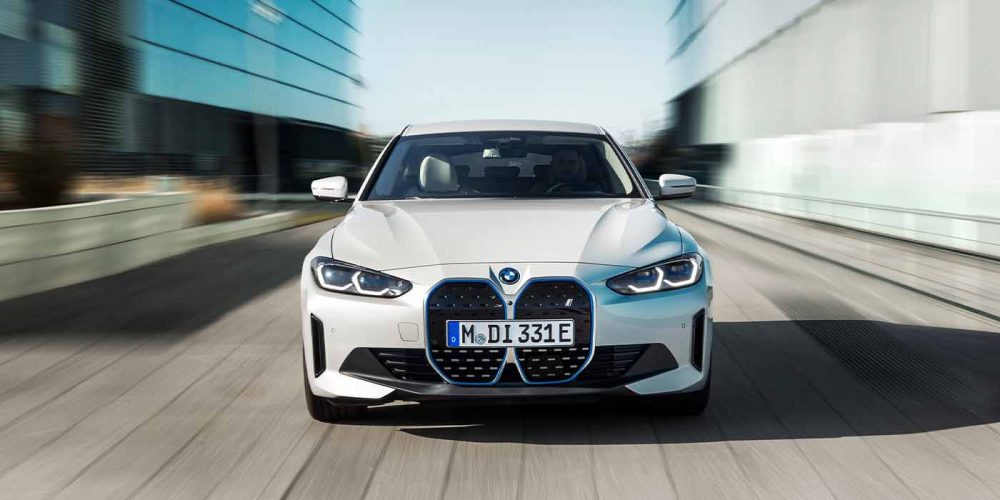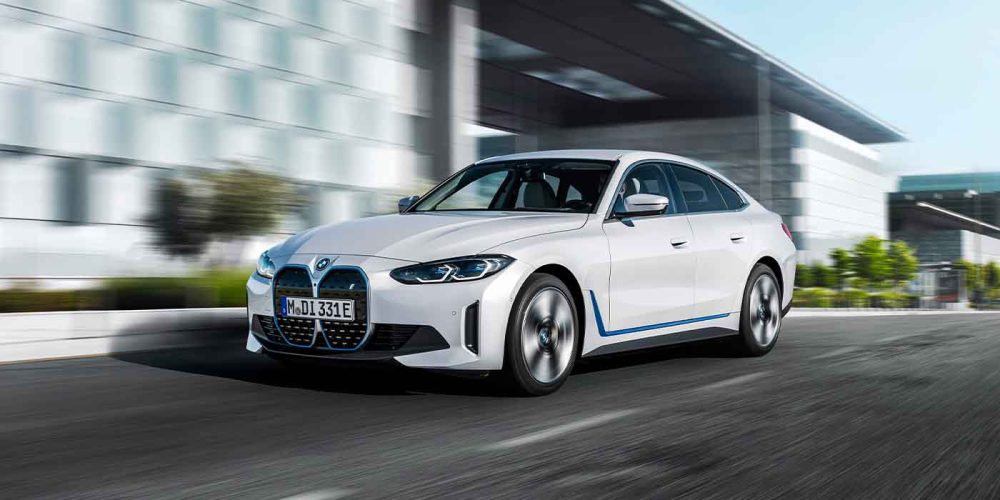
BMW announced a third variant to its all-electric i4 range today – the eDrive35. As a lower-performance, single motor EV, the eDrive35 will arrive as the most affordable option of one of BMW’s lowest-priced EVs. At just a few thousand dollars less than its eDrive40 sibling, we can’t help but wonder if this vehicle is necessary? You can learn more below and decide for yourself.
The BMW i4 is a flagship model for the German automaker as it slowly but surely transitions into an all-electric range of vehicles (well… 50% by 2030). Initial i4 deliveries began in the fall of 2021 and have included two different versions of the compact sedan – the eDrive40 and M50.
The model has since been joined by the iX SUV and its divisive front end, which will be followed by the much pricier i7 sedan, set to deliver in the US before the end of 2022. Although BMW has also promised to deliver a new electrified version of the X1 to arrive as its most affordable EV, the i4 currently holds the bargain crown.
Now, BMW has introduced a third variation of the i4 with an MSRP below the previous pricing basement with its eDrive40. Here’s the i4 eDrive35.
BMW i4 eDrive35 coming in Q1 of 2023 with 260-mile range
BMW officially introduced its newest and lowest-priced version of the i4 in a press release today, sharing some specs and pricing US consumers can expect to see.
According to the automaker, the latest version of the EV features the same Gen5 eDrive powertrain technology found within its i4 siblings as well as the iX. However, the BMW i4 eDrive35 features a smaller 70.2 kWh battery pack that offers 66 kWh net energy.
The result is lower estimated range, especially compared to the eDrive40 and its 81 kWh pack. The eDrive35 will also deliver significantly less horsepower and torque compared to both other models and slightly lower acceleration than its single-motor counterpart in the eDrive40.
Here’s a side-by-side comparison of all three i4 options:
| BMW i4 variant | eDrive35 | eDrive40 | M50 |
| Powertrain | Single-motor | Single-motor | Dual-motor |
| Battery pack | 70.2 kWh | 81 kWh | 81 kWh |
| Horsepower | 281 HP | 335 HP | 536 HP |
| Torque | 295 lb.-ft | 317 lb.-ft | 586 lb.-ft |
| Acceleration (0-60 mph) | 5.8 seconds | 5.5 seconds | 3.7 seconds |
| Est. Range | 261 miles | 282-301 miles | 227-271 miles |
| Starting MSRP* | $52,395 | $56,895 | $68,295 |
The last difference you’ll notice is starting MSRP. The i4 eDrive35 will be BMW’s most affordable EV option in the US, but even with destination and handling, it only costs $4,500 less than the eDrive40.
According to BMW, production of the i4 eDrive35 is expected to begin in Munich in Q4 of this year followed by US deliveries in Q1 of 2023.
Electrek’s Take
It’s never bad news when we hear of a new and more affordable EV trim, but in this instance, I’m scratching my head a bit.
The i4 is already BMW’s “affordable” EV option, and its two current versions are spaced out in price pretty well in my opinion, based on what you get performance-wise. I drove the M50 for a week and found it to be completely adequate, but to me it felt like a vehicle designed to help loyal BMW drivers transition to an EV.
It drove like a combustion car to me with its lack of true one-pedal driving and creeping any time you took your foot off the accelerator. Some people probably like that, but I personally don’t. Anyways, I digress.
We already have the single-motor BMW i4 eDrive40, another perfectly adequate option priced just over $55k. Totally fine. So why introduce a third option with slightly lower specs for $4,500 less? Once you’re over $50K, does that $4,500 really make that big of a difference?
Under the proposed bill to expand federal tax credits in the US, the new i4 found fall below the $55k cutoff for EV sedans and qualify, but BMW has already said this EV will be built in Germany, which would subsequently disqualify it for the full tax credit.
Personally, I’d spring for the eDrive40 just for the added range. The better performance would simply be a bonus. Did BMW have a bunch of extra smaller battery packs lying around and think, “what the hell, let’s throw together a third option?”
More options are usually better for consumers, especially when they are cheaper, but this new model feels half-baked and unnecessary to me. I’d rather see those efforts going into a BMW model priced in the $35-$40K range. Perhaps we’ll see that in the iX1.
FTC: We use income earning auto affiliate links. More.






Comments